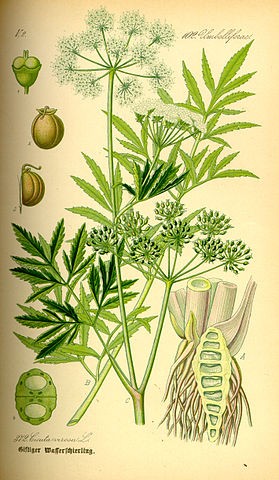Water Hemlock (Cicuta spp.) is a highly toxic plant that belongs to the Apiaceae family. There are several species within the Cicuta genus, and they are known for containing cicutoxin, a potent neurotoxin that can be deadly. It is crucial to exercise extreme caution and avoid any contact with this plant. Here’s a brief guide to Water Hemlock for awareness:
1. Identification:
- Appearance: Water Hemlock is a perennial herb that can grow up to 6 feet tall. It has compound leaves with toothed leaflets and produces small clusters of white or greenish flowers.
- Habitat: It is commonly found in wet areas, including marshes, streambanks, and ditches.

2. Toxicity:
- Cicutoxin Content: All parts of the Water Hemlock plant contain cicutoxin, a highly toxic compound.
- Lethal Poisoning: Ingesting even a small amount of any part of the plant can be lethal.
3. Dangers:
- Poisoning Symptoms: Water Hemlock poisoning can cause symptoms such as nausea, vomiting, seizures, respiratory failure, and death.
- Quick Onset: Symptoms can appear rapidly, and emergency medical attention is critical in case of suspected poisoning.
4. Avoidance:
- No Edible Parts: Water Hemlock has no edible parts, and any attempt to use it for food or medicinal purposes is extremely dangerous.
- Keep Away from Livestock: Livestock, including cattle, can be affected by Water Hemlock, leading to symptoms like drooling, convulsions, and death.
5. Similar Plants:
- Lookalike Species: Water Hemlock may be mistaken for other non-toxic plants like wild parsnip or other members of the Apiaceae family. Proper identification is crucial to avoid accidental ingestion.
6. Legal Status:
- Protected Species: In some regions, Water Hemlock may be a protected species due to its toxicity. It is important to be aware of local regulations.
7. Control Measures:
- Preventing Growth: If Water Hemlock is identified in areas where people or livestock frequent, control measures should be taken to prevent exposure.
- Professional Assistance: Removal of Water Hemlock should be done by professionals to ensure proper disposal and safety.
8. Educational Awareness:
- Public Awareness: Public education is crucial to make people aware of the dangers associated with Water Hemlock and the importance of avoiding contact with the plant.
9. First Aid:
- Seek Immediate Medical Attention: In case of suspected poisoning, seek immediate medical attention. Call emergency services and provide information about the plant ingested.
10. Land Management:
- Identification and Removal: In areas where land management is practiced, identification and removal of Water Hemlock should be part of the strategy to protect humans and animals.
Water Hemlock is a plant that poses a significant risk to human and animal health. Due to its extreme toxicity, it should be avoided at all costs, and efforts should be made to raise awareness about its dangers. If Water Hemlock is suspected or identified in an area, it is crucial to take appropriate measures to prevent accidental ingestion and to seek professional help for removal.











